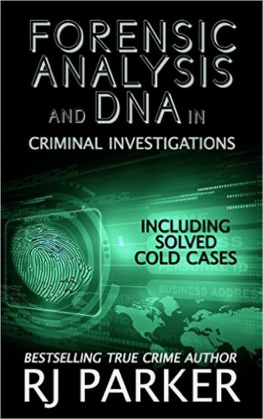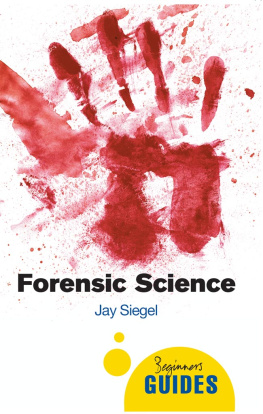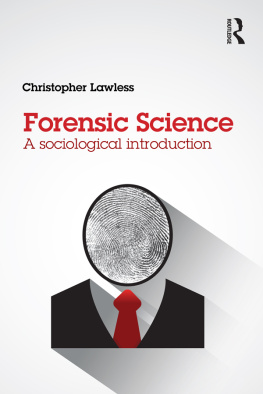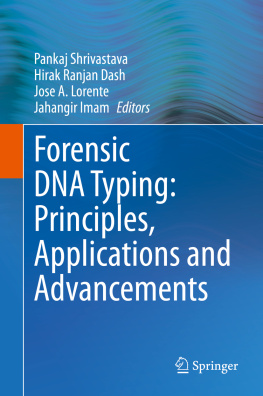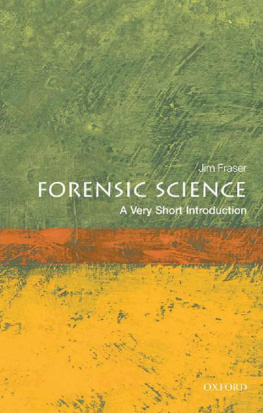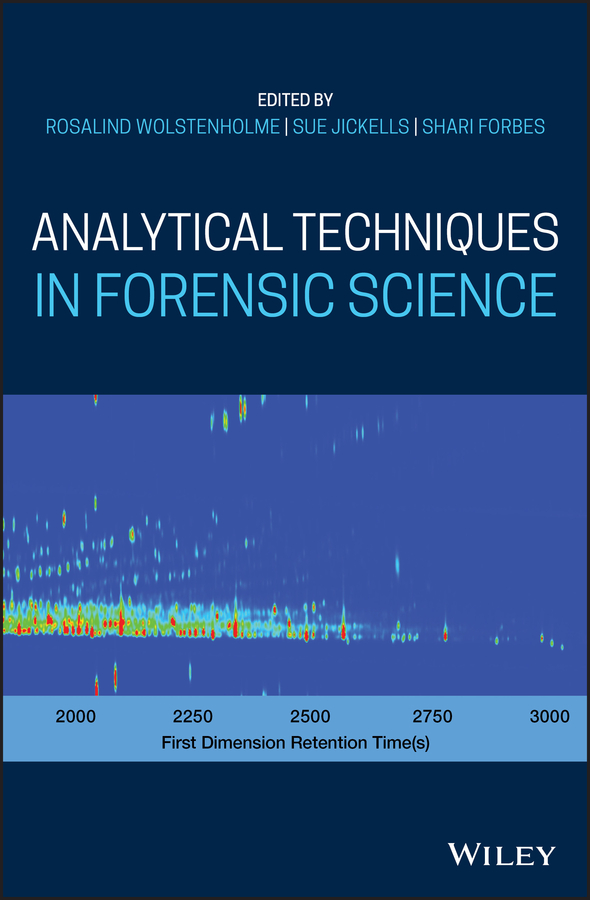
Table of Contents
List of Tables
- Chapter 1
- Chapter 3
- Chapter 4
- Chapter 6
- Chapter 7
- Chapter 8
- Chapter 9
- Chapter 10
- Chapter 11
- Chapter 12
- Chapter 14
- Chapter 15
List of Illustrations
- Chapter 1
- Chapter 2
- Chapter 4
- Chapter 5
- Chapter 6
- Chapter 7
- Chapter 8
- Chapter 9
- Chapter 10
- Chapter 11
- Chapter 12
- Chapter 13
- Chapter 14
- Chapter 15
Guide
Pages
Analytical Techniques in Forensic Science
Edited by
Rosalind Wolstenholme
Sheffield Hallam University
Sheffield, UK
Sue Jickells
Retired Analytical Chemist, formerly University of East Anglia and King's College
London
Shari Forbes
Universit du Qubec TroisRivires Qubec
Canada

This edition first published 2021
2021 John Wiley & Sons Ltd
All rights reserved. No part of this publication may be reproduced, stored in a retrieval system, or transmitted, in any form or by any means, electronic, mechanical, photocopying, recording or otherwise, except as permitted by law. Advice on how to obtain permission to reuse material from this title is available at http://www.wiley.com/go/permissions.
The right of Rosalind Wolstenholme, Sue Jickells and Shari Forbes to be identified as the authors of the editorial material in this work has been asserted in accordance with law.
Registered Offices
John Wiley & Sons, Inc., 111 River Street, Hoboken, NJ 07030, USA
John Wiley & Sons Ltd, The Atrium, Southern Gate, Chichester, West Sussex, PO19 8SQ, UK
Editorial Office
The Atrium, Southern Gate, Chichester, West Sussex, PO19 8SQ, UK
For details of our global editorial offices, customer services, and more information about Wiley products visit us at www.wiley.com.
Wiley also publishes its books in a variety of electronic formats and by printondemand. Some content that appears in standard print versions of this book may not be available in other formats.
Limit of Liability/Disclaimer of Warranty
In view of ongoing research, equipment modifications, changes in governmental regulations, and the constant flow of information relating to the use of experimental reagents, equipment, and devices, the reader is urged to review and evaluate the information provided in the package insert or instructions for each chemical, piece of equipment, reagent, or device for, among other things, any changes in the instructions or indication of usage and for added warnings and precautions. While the publisher and authors have used their best efforts in preparing this work, they make no representations or warranties with respect to the accuracy or completeness of the contents of this work and specifically disclaim all warranties, including without limitation any implied warranties of merchantability or fitness for a particular purpose. No warranty may be created or extended by sales representatives, written sales materials or promotional statements for this work. The fact that an organization, website, or product is referred to in this work as a citation and/or potential source of further information does not mean that the publisher and authors endorse the information or services the organization, website, or product may provide or recommendations it may make. This work is sold with the understanding that the publisher is not engaged in rendering professional services. The advice and strategies contained herein may not be suitable for your situation. You should consult with a specialist where appropriate. Further, readers should be aware that websites listed in this work may have changed or disappeared between when this work was written and when it is read. Neither the publisher nor authors shall be liable for any loss of profit or any other commercial damages, including but not limited to special, incidental, consequential, or other damages.
Library of Congress CataloginginPublication Data
Names: Wolstenholme, Rosalind, editor. | Jickells, Sue, editor. | Forbes,
Shari, editor.
Title: Analytical techniques in forensic science / edited by Dr. Rosalind
Wolstenholme, Dr. Sue Jickells, Prof. Shari Forbes.
Description: First edition. | Hoboken, NJ : Wiley, 2021. | Includes
bibliographical references and index.
Identifiers: LCCN 2020022864 (print) | LCCN 2020022865 (ebook) | ISBN
9781119978282 (hardback) | ISBN 9781119033813 (adobe pdf) | ISBN
9781119033820 (epub)
Subjects: MESH: Forensic Sciencesmethods | Chemistry Techniques,
Analytical
Classification: LCC RA1051 (print) | LCC RA1051 (ebook) | NLM W 700 |
DDC 614/.1dc23
LC record available at https://lccn.loc.gov/2020022864
LC ebook record available at https://lccn.loc.gov/2020022865
Cover Design: Wiley
Cover Image: Forensic science graph CReative
Commons source MDPI, https://doi.org/10.3390/separations3030026
List of Contributors
Sarah Benson
AFP (Australian Federal Police)
Canberra
Australia
Lucas Blanes
Oswaldo Cruz Foundation
Rio De Janeiro
Brazil
Alan Brailsford
King's College London
London
UK
Nerida Cole
Swinburne University of Technology
Melbourne
Australia
Wendell Karlos Tomazelli Coltro
Universidade Federal de Gois
Gois
Brazil
Philip Doble
University of Technology Sydney
Sydney
Australia
Shari Forbes
Universit du Qubec TroisRivires
Qubec
Canada
Ellen Flvia Moreira Gabriel
Universidade Federal de Gois
Gois
Brazil
Sue Jickells
Retired Analytical Chemist, formerly University of East Anglia
and
King's College London
UK
Tim Jickells
University of East Anglia
Norwich
UK
Kylie Jones
AFP (Australian Federal Police)
Canberra
Australia
Aleksandra Michalska
Institute of Forensic Research
Krakw
Poland
Robson Oliveira dos Santos
University of Santa Cruz do Sul
Santa Cruz do Sul
Brazil
Mark Parkin
Eurofins Forensic Services
London
UK
Luke N. Rodda
Office of the Chief Medical Examiner
San Francisco
USA
and
University of California
San Francisco
USA
Claude Roux
University of Technology Sydney
Sydney
Australia
Renata Mayumi Saito
Brazilian Navy Technology Center in So Paulo
So Paulo
Brazil
Barbara Stuart
University of Technology Sydney
Sydney
Australia
Sophie Turfus
University of Huddersfield
Huddersfield
UK
Rosalind Wolstenholme
Sheffield Hallam University
Sheffield
UK
Florian Wulfert
Sheffield Hallam University
Sheffield
UK
Grzegorz Zadora
Institute of Forensic Research
Krakw
Poland
and
University of Silesia in Katowice
Katowice
Poland
Preface
Forensic science is a fascinating and important subject. It provides vital information in many criminal and civil cases and allows courts to address the questions: what has happened and who is responsible? There are three main stages in the forensic science process: crime scene examination, where evidence is collected and preserved; laboratory examination of recovered evidence to determine if there are any associations between pieces of evidence; and court reporting, where the scientist presents their findings to the court. Scene examination and court reporting are well represented in forensic textbooks. However, as university lecturers interested in forensic chemistry, we saw a need for a textbook that combines analytical theory and forensic application. That is to say, for a book that looks at the interface between analytical chemistry and (primarily) trace evidence, where trace evidence means materials found in small quantities such as paint chips, fibres, and firearm discharge residue. We hope to provide the depth of technique theory and application required for students on science based forensic science undergraduate and postgraduate courses, bridging the gap between introductory and advanced texts. We also hope the book will serve as a resource for forensic scientists who may wish to broaden their knowledge of analytical forensic science or for analytical scientists who wish to apply their knowledge in a forensic context.
Next page

